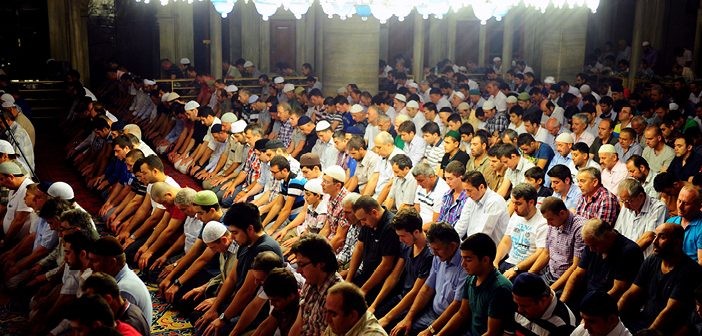
Historical Stages and The Representatives of Sufism
What is the historical stages of sufism? What is the representatives of sufism? What is the main idea of sufism?
From its beginning to the present day, Sufism has gone through various periods with different characteristics. According to the most common approach adopted by the historians of Sufism, it can be examined in four main periods: the period of asceticism (zuhd), the period of systematic Sufism, the period of philosophical Sufism, and the period of Sufi orders (ṭariqāt).
1) The Period of Zuhd
In the first two centuries of the Hijra (7th and 8th centuries), words such as zuhd, riqāq-raqāiq, taqwā, and ʿibādah were generally used for the depth and richness of a person’s inner world. Such people were given names such as zāhid, ʿābid (servant), nāsik (submissive), and qāri’-qurrā (reader, one who devotes himself to worship). These were people who were making preparations for the Hereafter rather than for the life of this world. Sufism aims to turn people to the hereafter rather than this world and to raise more qualified believers who have trained their souls based on the purification of the heart, good character, and spiritual maturity.
At the time of the Prophet, there were Companions with various tendencies. Some Companions gave more importance to worship and taqwā while some others had other interests such as dealing with knowledge, preaching religion, engaging in battles, and working as administrators. Especially, the first four caliphs and the ten Companions who were given the good news of Paradise, Companions such as Uthman ibn Maz’ūn, Musab ibn ‘Umayr, ‘Ammar Ibn Yasir, Ḥabbāb, Bilal, Suhayb, Salmān, Abu Dhar, Miqdād, Muadh, Abu al-Darda, Hudhayfa, Abdullah ibn ‘Umar and Abdullah ibn ‘Amr, were known as devotees and ascetics amongst the Companions. In later periods, believers who turned to asceticism and taqwā took them as an example. In a way, they formed the first link in the chain of Sufism.
The main representatives of the period of asceticism after the Companions are Uways al-Qarānī (d. 37/657), Ḥasan al-Baṣrī (d. 110/728), Jafar al-Ṣadiq (d. 148/769), Ibrahim ibn Adham (d. 161/777), Sufyan al-Thawrī (d. 161/777), Shaqīq al-Balḥī (d. 164/780), Dāwūd al-Ṭāī (d. 165/781), Abdullah ibn Mubārak (d. 181/797), Rābi‘ah al-‘Adawiyya (d. 185/) 801) and Fuḍayl Ibn Iyāḍ (d. 187/802).
2) The Period of Systematic Sufism
Starting from the 3rd (9th century CE) century of the Hijra, Sufism entered into a systematization process. In this period, while the principles, rules, and methods of Sufism were established, institutions bearing the influences of eastern and western cultures were developed. It is at this time that the stages (stations) and divine situations (states) of Sufism, which express spiritual progress towards Allah, were determined. Finally, this led to the principle of fanā’ (transformation of human qualities into divine qualities). This was followed by an understanding that sainthood was near and close to the understanding of prophethood. According to the systematized understanding of Sufism, while prophets could receive revelation from Allah only through an angel, saints received knowledge (inspiration) directly and without intermediaries. True knowledge (ma‘rifa) consisted of knowledge received directly from Allah. It was reported that the universe owed its existence and functioning to the group of saints called rijāl al-ghayb (lit. Men of the Unseen). Thus, Allah was manifested in the saint with all His names and attributes and was speaking through the saint’s mouth.[1]
The prominent Sufis who lived in this period and contributed to the systematization of Sufism are as follows: Bayazīd al-Bistamī (d. 261/874), Ḥakim al-Tirmidhī (d. 285/898), Hallaj al-Manṣūr (d. 309/921), Shihabuddin al-Suhrawardī (d. 587/1190), Fariduddin al-‘Aṭṭār (d. 620/1220), Mawlana Jalāladdin al-Rūmī (d. 672/1273), Sadreddin Konevi (d. 673/1274), Kemaladdin al-Kashānī (d. 730/1330), and Abdullah al-Bosnawī (d. 1054/1644).
Some views maintained in this new form that Sufism had gained during this time period were criticized by some Muslim jurists. Yet, this newfound understanding of mysticism continued its development including the doctrine of “the unity of existence (waḥdah al-wujūd)” by Muḥyiddin ibn al-ʿArabī (d. 637/1239). In his works entitled al-Futuḥāt al-Makkiyya and Fuṣūṣ al-Ḥikam, Ibn al-ʿArabī explained the relationship between God and the universe, and God and the human being on the basis of the doctrine of the unity of existence (waḥdah al-wujūd). He tried to prove his thoughts with some pieces of evidence from philosophy and theology. Sufis such as Sadreddin Konevi, Fakhraddin al-Iraqī, Abdulkarīm al-Jīlī, Ibn Fāriḍ, Aziz al-Nasafī, Abdurrazzāq al-Kashānī, and Jāmī followed him on this path and transmitted the doctrine of the unity of existence to the next generations.
3) The Period of Philosophical Sufism
While Sufism continued its development that resulted in the philosophy of the unity of existence, in the face of strong criticisms, it became necessary to follow a path that would not contradict the general principles of Islam. Here, the attempt was to balance the previously developed theory with an opposite theory such as fanā (annihilation) versus baqā (eternal union), or to reinterpret the developed theory in accordance with Islamic principles. In this period, reason and rational thought were given much importance. For that reason, the doctrine of waḥdah al-shuḥūd (the unity of witness) was developed against the doctrine of waḥdah al-wujūd (the unity of existence).
The prominent Sufis who are considered to be the representatives of this new understanding are as follows: Junayd al-Baghdadī (d. 297/909), Hārith al-Muḥāsibī (d. 243/857), Sarrāj (d. 378/988), Abu Ṭālib al-Makkī (d. 386/996), Kalabazī (d. 380/990), Qushayri (d. 465/1072), Ghazali (d. 505/1111), and Imam Rabbani (d. 1034/1625). With the works they wrote, the principles of Sufism were established. While this mystical development, which developed in Iraq and India continued, two more important mystical schools called “malāmah” and “futuwwah” emerged in the Khorasan region in the same period. In the Khorasan region, Ḥamdūn al-Qaṣṣār (d. 271/884) put forward a different interpretation of spiritual life under the name of malāmah. Religious people from Khorasan such as Abu Ḥafṣ, Aḥmad Ibn Khaḍrawayh, and Shah Shujā al-Kirmānī focused on futuwwah and muruwwa. While the people of malāmah focused on the issue of sincerity and hypocrisy, the people of futuwwa mostly focused on the religious education of the youth.
4) The Period of the Sufi Orders (Ṭariqāt)
Sufism, which had been systematized in two different directions in the previous period, entered the process of institutionalization and organization as of the second half of the 6th (12th) century hijra. The Sufis, who redefined some of the rules and methods of Sufism with some differences, established the Sufi Orders (ṭariqāt) under their own names. Thus, they enabled Sufism to spread more rapidly among the people. These have continued their existence in the entire Islamic world until today. The prominent sufis who were the founders of the sufi orders are: Abdulqādir al-Jilanī (d. 562/1166 Qadiriyya order), Ahmed Yesevi (d. 562/1166 Yasawiyya), Ahmad al-Rifaī (d. 578/1183 Rifaiyya), Najmaddin Kubra (d. 618/1221 Kubrawiyya), Suhrawardī (632/1235 Suhrawardiyya), Abu al-Hasan al-Shazalī (d. 632/1273), Shazaliyya), Mawlana Jalāladdin al-Rumī (d. 672/1273 Mawlawiyya), Bahauddin Naqshiband (d. 791/1388 Naqshibandiyya), Siraj al-din ‘Umar (d. 800/1397 Khalwatiyya), and Hacı Bayram Veli (d. 833/1429 Bayramiyya).
These Sufi orders spread across all Muslim countries from Morocco to Indonesia, from Somalia to Kazan through their followers and disciples of their masters. In addition to Mawlavism, other Sufi orders such as Bektashism attributed to Haci Bektashi Veli (d. 670/1271), Bayramiyya attributed to Haci Bayram Veli (d. 833/1429) and Jalwatiyya attributed to Aziz Mahmud Hüdâyî (d. d. 1038/1628), were formed in the period of Seljuks and Ottomans. Moreover, Sheikh Naṣiruddīn (d. 660/1262) known as Ahi Evren established the Ahi organization in Kırşehir. The futuwwah was organized in many cities in Anatolia. After Anatolia was conquered in 1071, veteran dervishes, alperens, and Sufis of Khorasan from Iraq, Syria, and Khorasan regions were instrumental in the spread of Islam in Anatolia and the Balkans.[2]
When Sufism and Sufi communities emerged, they needed places and buildings for their activities. In the early periods, places such as mosques, masjids, houses, and workplaces were the meeting, conversation, and discussion places of the Sufis. However, as the Sufi organizations expanded and grew, new places and buildings were needed. As al-Harawī stated in his Ṭabaqāt al-Ṣufiyya, the first Sufi institution was established in Syria in the city of Remle under the name of khankah. The number of these institutions increased rapidly over time. In various periods and regions, these institutions were given various names such as ribāt, takka, zāwiya, dargah, and asitanah. These became institutions where various religious and worldly sciences were taught, as well as Sufi instruction. They also carried out the duties of madrasahs, especially in the rural areas. Moreover, they became important social institutions where travelers and the poor found accommodation. In time, many foundations (waqf) were established for the needs of the dervish lodges through donations made by statesmen, benefactors, and members of the Sufi order. This enabled the Sufi orders to carry out their duties effectively. In addition, dervish lodges became cultural centers where many fine arts, especially poetry, literature, and music, originated and developed.
[1] Ahmet Özalp, “Tasavvuf”, Şamil İslam Ansik., Şamil Yayınevi, Istanbul.
[2] Heyet, ʿIlmihal, I, 59.












